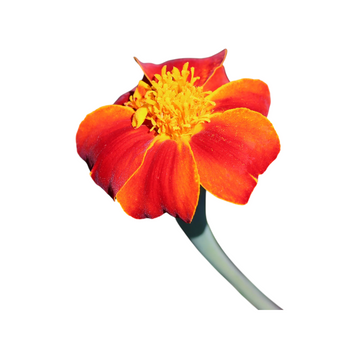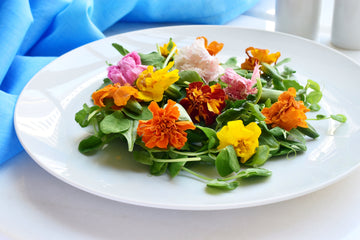Marigold Burning Embers Gem

Freshly Harvested

Non-GMO & Natural

Nutrient Dense

Trusted by Chefs
15 Seeds+
🌼 Marigold ‘Burning Embers Gem’ Flower Seeds
Tagetes tenuifolia
A fiery standout 🔥🌿, Burning Embers Gem Marigold is an heirloom variety with glowing orange-red petals edged in gold ✨. Compact and endlessly floriferous, it delivers edible blooms with a tangy citrus-marigold bite 🍊🌸. Equally at home in the garden and on the plate, this marigold shines as a pest-repelling companion plant 🌱🐜 while offering chefs a vibrant garnish that doubles as flavor.
👅 Flavor Profile:
Tangy citrus 🍊, slightly bitter 🌿, with peppery marigold spice 🌶️.
🍴 Culinary Uses:
🥗 Sprinkle petals into salads for fiery color + citrusy zest
🍸 Float blooms in cocktails & syrups for dramatic presentation
🥘 Infuse into rice or stews as a “poor man’s saffron” substitute
🧁 Use as edible décor on cakes, pastries, and desserts
🍵 Brew into herbal teas for a tangy, peppery kick
👨🍳 Chef’s Pitch:
Marigold ‘Burning Embers Gem’ is edible fire in bloom 🌼👨🍳🔥. With its blazing red-gold petals and bold citrus-marigold flavor, it transforms plates, cocktails, and baked goods into vibrant works of art. Hardy, compact, and constantly blooming, it’s a chef’s garnish and gardener’s ally in one package.
🌱 Growing Notes:
🪴 Compact annual, 12–16” tall, bushy growth habit
🌼 Masses of bi-colored orange-red flowers with golden edges
🌞 Loves full sun, drought-tolerant once established
⏱ Blooms continuously summer → frost
🐝 Attracts pollinators while repelling nematodes & pests
✨ Quick Facts:
-
Latin Name: Tagetes tenuifolia (‘Burning Embers Gem’)
-
Habit: Annual, compact 12–16” tall
-
Flavor: Tangy citrus-marigold, slightly bitter
-
Culinary Uses: Garnishes, teas, cocktails, rice, baked goods
-
Companion Planting: Pollinator-friendly + natural pest repellent

Marigold Burning Embers Gem

Let’s Manifest Beauty.
Edible Flowers that Smile.
Edible flowers are more than just decoration — they’re a chef’s secret for adding elegance, fragrance, and subtle flavor to a dish. From citrusy marigolds to honey-sweet alyssum and tangy begonias, these delicate blooms transform plates into experiences. Each petal offers color, aroma, and taste, turning simple ingredients into a culinary statement.

Flowers are here to stay
The Art of Garnishing with Edible Flowers
A garnish should do more than decorate — it should enhance. Edible flowers bring color, fragrance, and subtle flavor to the plate, turning simple dishes into memorable experiences. From delicate petals scattered across a salad to a single bloom crowning a dessert, flowers add elegance and elevate presentation in ways that engage every sense.
The Secret Ingredient Chefs Trust
Widely used in professional kitchens, microgreens enhance flavor profiles while adding nutrition and a striking visual appeal to everything from sandwiches to fine dining creations.
Frequent Asked Questions
Q: What are Microgreens?
Microgreens are young, tender plants harvested just after the first leaves develop. They’re packed with flavor, color, and nutrients, making them both delicious and healthy.
Q: Are microgreens really more nutritious than regular vegetables?
Yes. Research shows that microgreens can contain up to 40x more vitamins and antioxidants (like A, C, K, and E) compared to their mature counterparts.
Q: How do I use microgreens in my meals?
They’re incredibly versatile—use them as a garnish, in salads, on sandwiches, in wraps, smoothies, soups, or even as a centerpiece ingredient in gourmet dishes.
Q: How long do microgreens stay fresh?
Stored properly in a fridge, microgreens typically last 5–7 days. To keep them at peak freshness, store them dry in a breathable container.













